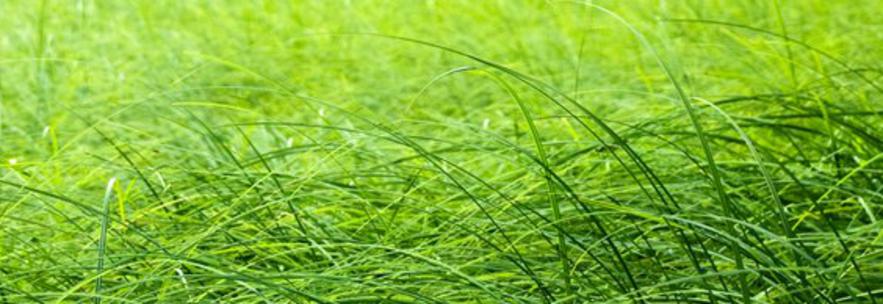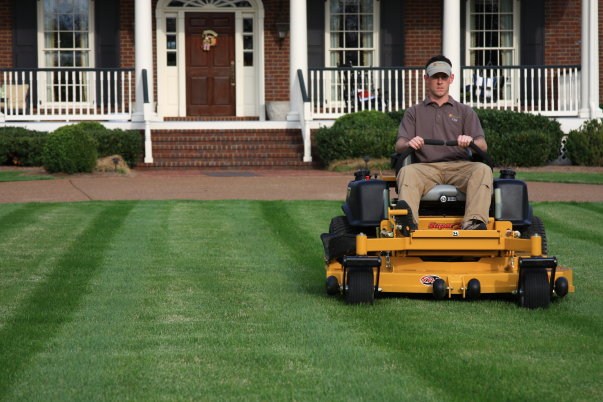Lawn Services of Omaha - Lawn and Landscaping
Growing Grass Under Trees
by David Steg on 02/22/16
Is it Possible or Impossible to Grow Grass Under Trees?
More times than not, we see ugly patches of little to no grass beneath our trees. It seems like a constant defeat to get grass to grow, but fear not! It is possible to grow lush green grass under your trees. There are two factors that make growing grass under trees a rather difficult task. One of the main reasons, is that grass has to compete with the tree roots for water and nutrients. The blades of grass are also shaded by the tree’s canopy, so the grass beneath the tree gets little sunlight.
A few key points to note when trying to promote grass growth under a tree:
- Thin out the tree’s canopy to allow the maximum amount of sunlight to reach the ground. This should be done every few years, but never top off a tree. This will eventually kill it, and is unlawful in may cities.
- Keep the height of grass taller under the tree when mowing. The longer the blades of grass, the better they are able to grab the available sunlight. Also, the longer the grass the deeper the roots, which allow for them to obtain more water.
- Especially in dry weather conditions, water the area under the tree thoroughly. The area under a tree is very dry, since the tree roots will take up as much water as possible. Keeping the ground moist, will promote healthier grass.
If you wish to grow grass under a tree, re-seeding is essential. Most lawns will need to be reseeded very year or two, especially in areas under a tree. For best results, it is important to add enough soil to create a seed bed. This will allow for root growth on the grass and help cover some of the tree roots. Please beware that when adding soil near a tree that it shouldn’t be in large mounds. Adding too much soil can harm your tree. Also, if the soil is too close to the base of the tree, it can cause the trunk to rot or promote fungus. It is best to contact an arborist if you plan to add additional soil around a tree.
Some tree’s will not allow for grass to grow, no matter what you do. Instead of wasting time and money, it may be best to mulch those areas. Again, be sure to spread the mulch thinly and evenly to keep your tree happy and healthy.
6 Step Lawn Fertilization Program
by David Steg on 02/15/16Do I Really Need to Follow a 6 Step Fertilization Program?
Winter Effects on Lawn Health
by David Steg on 02/08/16
What is winter kill and what does is do to my lawn?
We often think the lawns should only be cared for during warmer weather, but that isn’t true. Lawns should be taken care of year round for the best possible results. After winter, many homeowners will notice brown / dead spots in their lawns, which is known as winter kill. This can be a sign of seasonal maintenance problems. There are a few common causes for this phenomena, including disease, freeze damage, and general stress.
• Disease – Funguses and plant viruses attack grasses that are under stress, then weaken and infect them. The fungus will take away the required nutrients for healthy grass and can cause die-off during the winter.
• Freeze Damage – Hard soil and the lack of moisture are the two main causes of freeze damage that leads to winter kill. Dry soil becomes is more easily compacted and becomes hard, which allows for it freeze faster and deeper than well-hydrated soil. During very cold weather, these conditions cause damage to grass roots, which are unable to tolerate the extreme cold.
• General Stress – The largest factor to winter kill is stress. This can come in the form of disease, root damage from dehydration, or continued damage from drought. The best solution is to remove sources of plant stress to ensure a healthy lawn come spring.
What Contributes to Winter Kill?
The biggest cause of stress to a lawn is improper watering. The roots become stressed and are therefore prone to disease and weaknesses, because they are unable to get nourishment . These roots are unable to grow deep into the ground which will usually cause the grass to die. To prevent winter kill, a homeowner must provide adequate care according to their grass type and local weather conditions – especially in the fall. Feeding, aerating, and dethatching should be performed regularly. Most importantly, a homeowner must learn how to water correctly to promote deep, thick roots. It is important to understand the type of grass you have and follow the suggested watering. Saturating the soil can be goo because this will cause the roots to grown deeper and make the grass stronger. Too many surface roots, will more likely die with improper watering and hot summer days. Winter kill is a devastating condition that can affect lawn that are not as healthy as they appear It is always good to consult with your lawn care specialists to ensure your lawn is getting the proper care it needs.
Strategies to Help Eliminate Weeds
by David Steg on 01/27/16Weeds, weeds, weeds; everybody has them, but nobody likes them! As a homeowner, we pride ourselves in our well kept lawns, but nobody said it was easy to keep it weed free. Sometimes it feels like we can do all the right things and they still come. Today I will go over a few strategies that will help simplify your weed control.
- Hand-pull the clumps so that it is unable to reseed itself. Add new grass seed if the patches create bare spots in the yard.
- Let it grow and wait until the following spring to treat, since the weed will die in the winter.
- Treat the clumps with a post- emergent crab grass killer. This will be most effective for younger plants, but once the seed heads form in the late summer this method will not work. It will be better to wait until the spring to apply a preventer.
Over-seeding in Spring
by David Steg on 01/15/16
We all want beautiful thick green grass, but this doesn’t happen with only sun and water. Spring over-seeding might be the best option for returning a thin or damaged lawn to health, because it will help fill in damaged areas and bare patches. This technique is used for larger areas where the turf is thin, but not bare. Spring overseeing will also help lawns resist stresses that an be caused by diseases, insects, and drought.
The effectiveness of over-seeding is enhanced when it is combined with lawn aeration. Aeration will allow water, air and fertilizer to penetrate the soil and have better access to turf grass roots. When overseeing, aeration will also allow for better seed-to-soil contact, which greatly aids seed germination and the growth of seedlings. It is important to note, that the use of fertilizers and pesticides should not be used when overseeing. These chemicals will halt the germination of the seedlings and will not provide the desired results.




